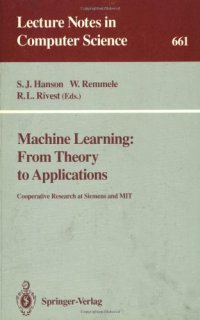
Ebook: Machine Learning: From Theory to Applications: Cooperative Research at Siemens and MIT
- Genre: Education
- Tags: Artificial Intelligence (incl. Robotics), Computation by Abstract Devices, Processor Architectures
- Series: Lecture Notes in Computer Science 661
- Year: 1993
- Publisher: Springer-Verlag Berlin Heidelberg
- Edition: 1
- Language: English
- djvu
This volume includes some of the key research papers in the area of machine learning produced at MIT and Siemens during a three-year joint research effort. It includes papers on many different styles of machine learning, organized into three parts. Part I, theory, includes three papers on theoretical aspects of machine learning. The first two use the theory of computational complexity to derive some fundamental limits on what isefficiently learnable. The third provides an efficient algorithm for identifying finite automata. Part II, artificial intelligence and symbolic learning methods, includes five papers giving an overview of the state of the art and future developments in the field of machine learning, a subfield of artificial intelligence dealing with automated knowledge acquisition and knowledge revision. Part III, neural and collective computation, includes five papers sampling the theoretical diversity and trends in the vigorous new research field of neural networks: massively parallel symbolic induction, task decomposition through competition, phoneme discrimination, behavior-based learning, and self-repairing neural networks.
This volume includes some of the key research papers in the area of machine learning produced at MIT and Siemens during a three-year joint research effort. It includes papers on many different styles of machine learning, organized into three parts. Part I, theory, includes three papers on theoretical aspects of machine learning. The first two use the theory of computational complexity to derive some fundamental limits on what isefficiently learnable. The third provides an efficient algorithm for identifying finite automata. Part II, artificial intelligence and symbolic learning methods, includes five papers giving an overview of the state of the art and future developments in the field of machine learning, a subfield of artificial intelligence dealing with automated knowledge acquisition and knowledge revision. Part III, neural and collective computation, includes five papers sampling the theoretical diversity and trends in the vigorous new research field of neural networks: massively parallel symbolic induction, task decomposition through competition, phoneme discrimination, behavior-based learning, and self-repairing neural networks.